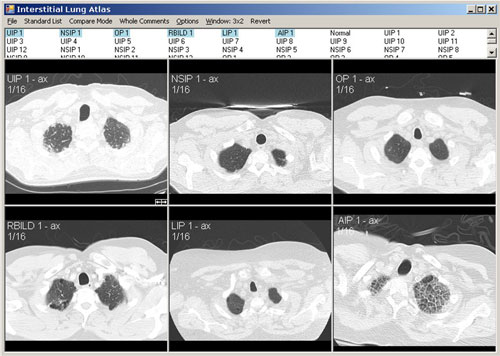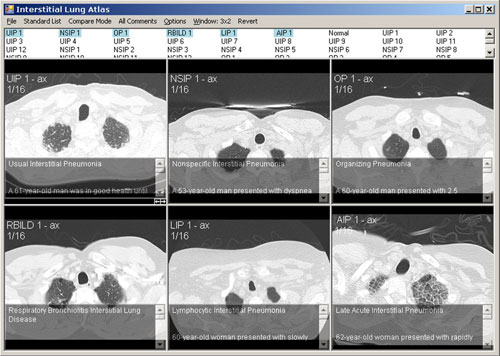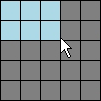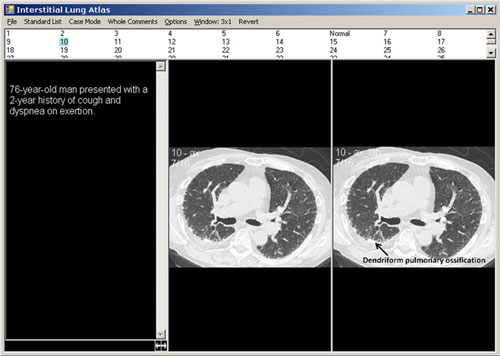How to Use
High Resolution CT Atlas of Interstitial Lung Disease: A Quick Tutorial
By default the atlas opens in Compare Mode (multiple patients, single series) showing a single case of each of the six main types of interstitial lung diseases in the Standard List.
It should look something like this:

Basic Image Navigation - Quick Start
The box below the menu bar contains a list of cases of interstitial lung disease (ILD) listed by diagnosis. The highlighted cases/patients are the ones currently assigned to the viewing windows. You can click on any case in the list to start with a new set of cases in the viewing windows, or you can click on the forward and reverse arrows in the first viewing window to move through the cases.
To scroll through the images of a series, left-click on a window and hold the left mouse button as you move the mouse up and down.
Hold down the right mouse button to select a different series to place in a viewing window.
The two image series in this atlas are both axial images sets, one of which has labels (ax_lab). The other series are the case history (Hx), and case diagnosis and findings (Dx).
By default, all appropriately linked windows will scroll at the same time as the window you scroll. If you want to unlink or re-link the image scrolling, go into the "Options" menu and check or uncheck the "Link Image Sets When Scrolling" option.
The atlas can be resized by putting the mouse cursor on a corner of the atlas, left-clicking the mouse and dragging the mouse across the screen.
Menu Bar Controls
Case list selection

The default case list is the Standard Listwhich contains the core, or most applicable, cases,a normal case as well as varying presentations of the six core ILDs. By clicking on Standard Liston the menu bar you can switch to two other lists.
Expanded Listis not used in this module, but could be used to add additional cases at a future date.
The Checked Onlylist adds checkboxes next to the Standard List cases. This allows you to customize exactly which cases are to be viewed. In this mode, only the checked cases will be shown in the viewing windows. For example:

Mode selection

The initial display mode is Compare Mode.You can change the display mode by clicking Compare Modeon the menu bar and then selecting one of the three options that appear. It will then change the menu title to the newly selected option.
Compare Modeallows you to compare the same series over multiple cases. If you right-click on a viewing window and select a series, the program will open that series for all of the selected cases. Only one series can be shown at a time in compare mode. To scroll forward and backward through a series left-click on a window and hold the left mouse button as you move the mouse up and down.
Case Modeallows you to compare labeled and unlabeled series of a single case. Only one case will be selected at a time (the default is the case in the upper left window). Changing the selected case will change all the viewing windows and load the labeled and unlabeled series for the new case.
Sheet Modeallows you to view one series from one case in detail. It opens the series currently residing in the first viewing window into an array-viewing mode simulating a printed sheet of film.
Comment selection
The image sets have comments associated with them. There are three modes for viewing comments, which can be changed from the comments menu ("Whole Comments"by default).

No Comments:No comments shown.
Show Single Image Comments:When you move the mouse over an image, any comments associated with the image will pop up and be shown.
Show All Image Comments:A small comment window will pop up at the bottom of every image window and stay visible, showing the comments associated with each window's image. This should look like this:

Show Whole Comments Only:This mode will just shows comments for the patient History (Hx) as well as case diagnosis and findings (Dx).
Options selection

Show Preset Levels Only:Not applicable for this module
Link Image Sets When Scrolling:You can toggle the linked scrolling of axial images using this checkbox.
Alternate List Names:Select to toggle between the cases labeled with their diagnoses on the top scrollbar to the cases being labeled as unknowns.

Window selection
The viewing windows start out as a 3×2 array. Also note the two small arrow buttons in the lower right-hand corner of the upper-most left window. These buttons allow you to cycle forward and backward through the case list without having to manually click the case list. You load series into the viewing windows by right-clicking within a viewing window and selecting the series. However, be aware that there are three different modes that will affect the behavior of the viewing windows.
To change the layout of the viewing windows, left-click the Window: 3×2menu option. This will pop up a small window with a 5×5 grid that looks like this:

Move the mouse around on the grid to select the new window arrangement layout that you want, and then click it. The viewing windows will rearrange themselves and load the appropriate series automatically.
Suggested way for looking at unknowns

- Change the 3x2 window to a 3x1 window using the Window tab of the tool bar.
- Using the mode selection tab, change from compare mode to case mode.
- Using the Options tab of the tool bar, deselect "Alternate List Names" so that the cases now show up as unknowns.
- In the first box, right click and pick "Hx" series. In the second box, right click and pick "ax" series. In the third box right click and select "ax_lab" series.
- Under drop down menu for Comments choose "Show Whole Comments Only."
After you look at a case, you can right click in the first box and select "Dx" to look at the diagnosis and findings.
